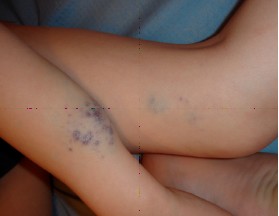(hereditary multiple glomangiomas, glomangiomatosis, multiple glomus tumors, malformations with glomus cells)
Unknown prevalence. Hereditary vascular malformations characterized by the presence of small blue-purple multifocal venous lesions at the level of the skin. Autosomal dominant transmission of mutations of the GLMN gene (on 1p22.1) that codes for glomulin. Lesions may be due to a local complete loss of the glomulin, a protein specifically expressed at the level of vascular smooth muscle cells. At histology, there are typical rounded cells called glomus cells in the wall of the distended vein-like channels. They are probably incompletetly differentiated vascular smooth muscle cells.
Clinical presentation: the lesions are present at birth and grow slowly during childhood. New small lesions appear with time. They are usually hyperkeratotic, curved and nodular. Their colour varies from pink to purple-blue. However, in some cases (especially in infants) lesions may be flat and purple, becoming darker with time. The lesions are often painful at palpation and do not completely disappear at compression. They are usually multifocal and located mostly on the extremities at the level of the skin and hypodermis. They are rarely present at the level of the mucous membranes. The size, location and number of lesions are highly variable, even within the same family.
Treatment: plastic and reconstructive surgery, indicated according to the size and location of the lesions. Sclerotherapy with ethanol (96%) may be indicated in some cases.

Anesthetic implications:
according to the localization of the lesion
References :
- Barreau M, Dompmartin A.
Les malformations cutanées vasculaires non-syndromiques.
Ann de Dermato & Vénérol 2014 ; 141 : 56-67.
- Cavalli R, Milani GP, Chelleri C, Donelli S, Fossali EF.
Plaque-type glomuvenous malformations in a child.
Lancet 2015 386 : e61
Updated: April 2019